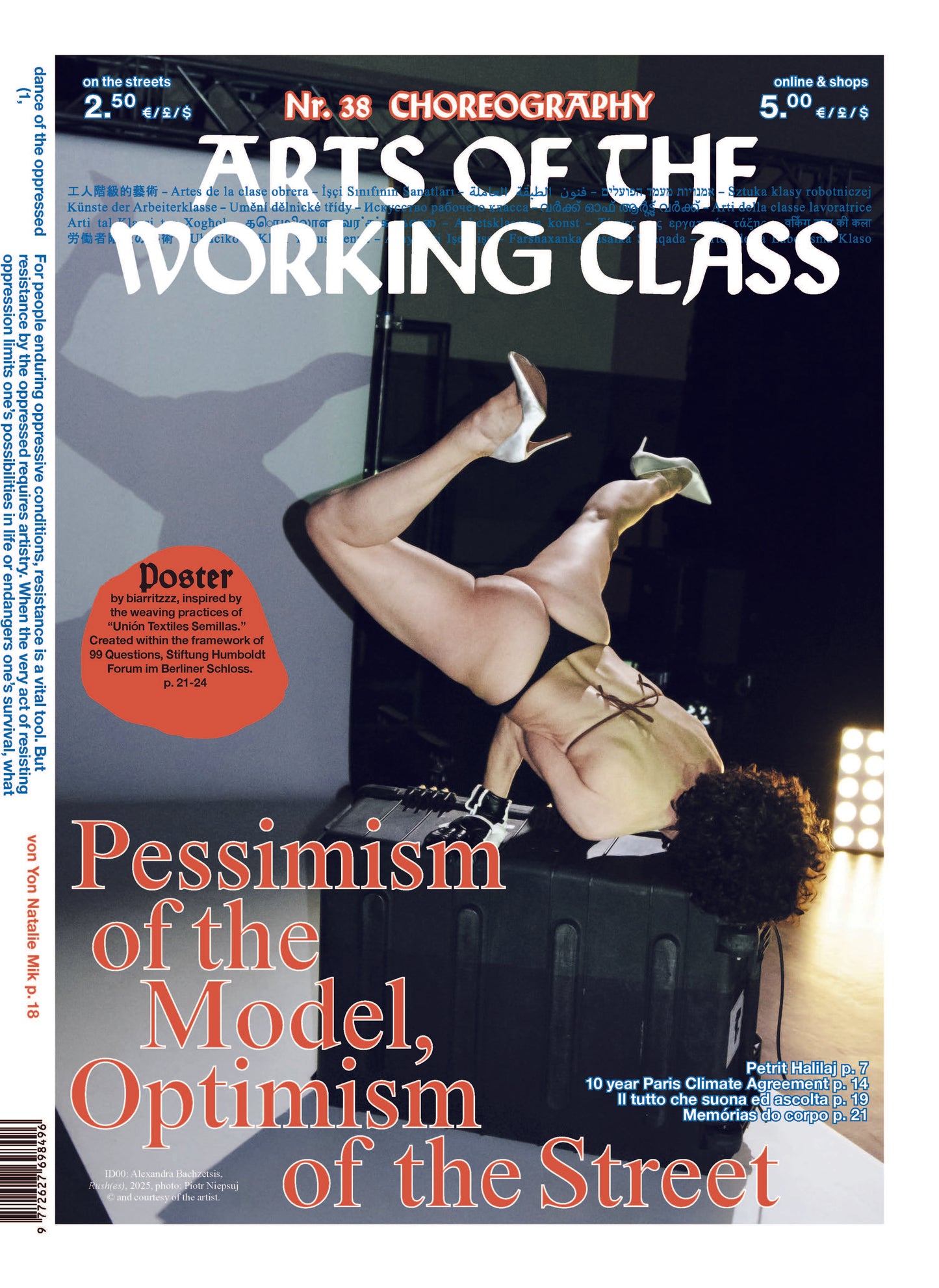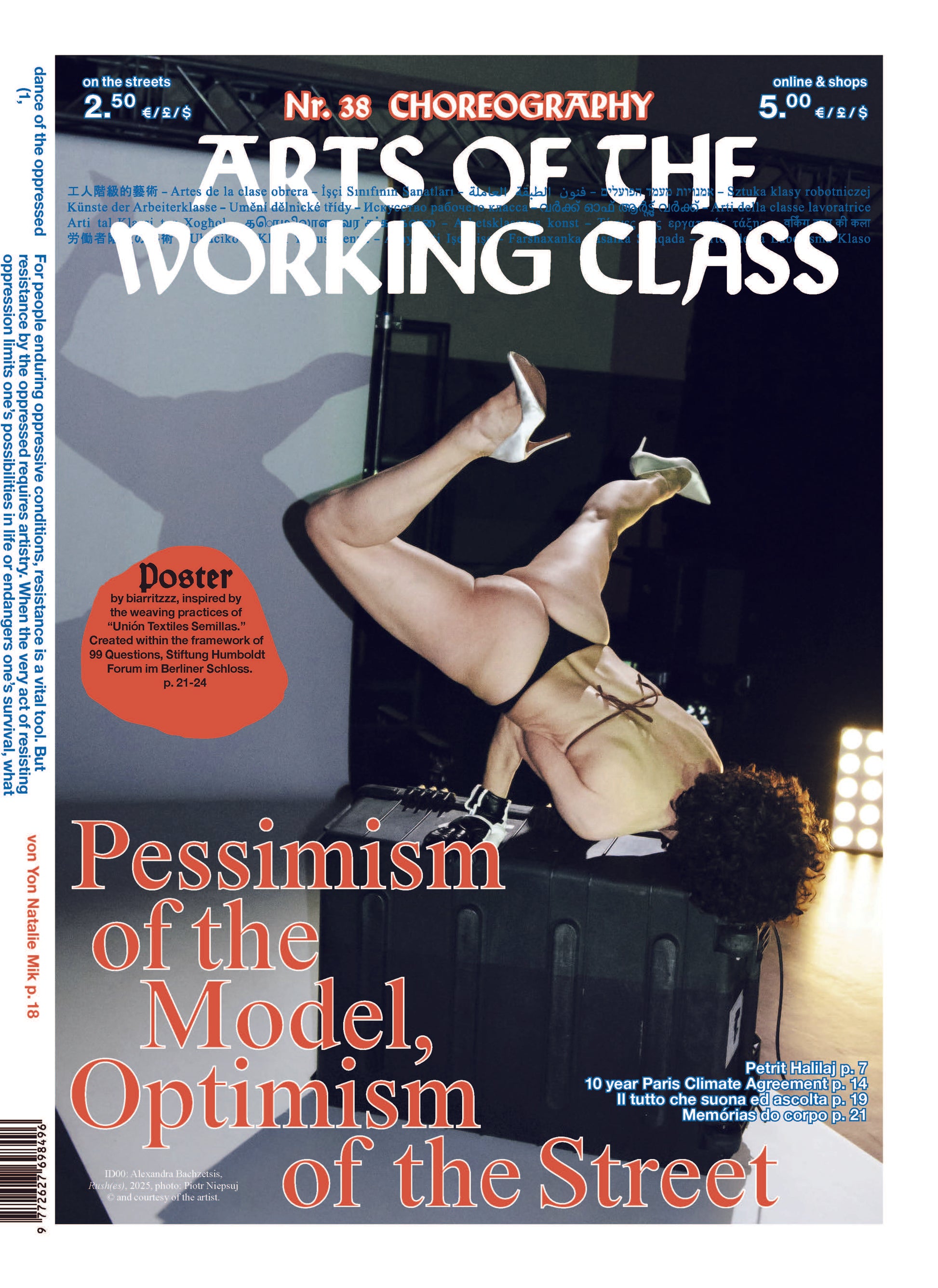Arts of the Working Class
ISSUE 38: CHOREOGRAPHY
ISSUE 38: CHOREOGRAPHY
Couldn't load pickup availability
To move is to think, and to orient our bodies differently is to think otherwise. Since our political leaders put the Books of Laws at the service of the profit of a power-thirsty minority, ideology is now easily choreographed into propaganda. Acknowledging one’s position of dissent as an innate opposition to fascism becomes the first gesture toward opening spaces of possibility. We adapt Antonio Gramsci’s maxim—“pessimism of the intellect, optimism of the will”—into: “the pessimism of the model, the optimism of the street,” invoking forms of collectivity that refuse definition within hegemonic social scores, and of course, modes of redistribution of wealth to which we have remained committed since 2018.
Issue 38: Choreography inquires into how memories, histories, and rituals transform individuals into groups, words into policies, threads into textures, notes into dances, gestures into positions. Today, choreography thrives not only on stage but through social media, where short videos compress movement into consumable poses—endlessly repeated and algorithmically rewarded. Here the body mirrors Mark Fisher’s architecture of capitalist realism: gestures circulate even as they are emptied of meaning, as if there were no alternative but to keep performing. It is a dance of reflexive impotence, where participation feels inevitable and refusal unimaginable.
Homogenizing forces remain powerful. Histories flatten differences. Memories are standardized. Laws enforce conformity. Habits reproduce the same gestures. Power maintains its choreography by repetition, making us forget other ways of moving. In contrast, we turn to particular, historical, and material forms of choreopoetics—their capacity to fracture inevitability, to make meaning in other ways, constellations that meander or pause, strategies that resist capture. The body is the site where we free one another, however briefly, from the script of inevitability.
Artists induce these moments of exception. Alexandra Bachzetsis unsettles the pleasure of belonging, repeating gestures until power reveals itself beneath the skin. Nairy Baghramian’s fractured forms for her upcoming show at WIELS, Nameless, embody precarity as resistance, fragments that refuse the smoothness of a world wherein “there is no alternative”. Petrit Halilaj’s Syrigana assembles opera, folk traditions, and gathers community into a polyphony that disrupts homogenization. Mark Leckey’s turn toward spirituality stages a hauntological choreography, summoning the invisible that capitalism insists cannot return. Adam Fearon’s Parade confronts fragility not as weakness but as a mode of possibility: chains at the point of breaking, gestures poised for release.
Elsewhere, Commonplace gathers us in domestic rituals—ORSHI’s doubt-resolving circles, Afrang Malekian’s convivial meals. The Community Summer School imagines neighborhood knowledge as a collective rehearsal for another future. Specialists from the Amsterdam School of Law expose law’s intrinsic contradictions; it is slow and compromised, yet still capable of emancipatory turns. For Phenomena, Yon Natalie Mik composes the act of squatting as rhythmic critique, while Caterina Barbieri invokes music’s democratic relief from quotidian alienation. Our poster, realized with the Humboldt Forum, honors ancient weaving technologies across the Global South, knots of solidarity reclaiming cosmologies flattened by colonial choreographies.
The Model pessimistically reproduces repetition. The street optimistically makes a turn. This is our invitation: to find distinction in the universal, curiosity in the deviant, and strength in the body that refuses its assigned choreography. Together with Architects for Tempelhofer Feld, we extend this inquiry into urban space: toward practices that reclaim the city for the many, against the planning choreographed by the few.
What does an open field represent in the collective imagination? How do we choreograph its life together?
Architecture operates as a contested battlefield, a structured field where practitioners compete for capital while navigating entrenched power systems. The very professional dynamics that shape architects also determine the fate of public spaces like Tempelhofer Feld. When architectural incumbents prioritize prestigious commissions and conventional success metrics, they enable the financial logic that threatens to concrete over Berlin's largest open space. When insurgent practitioners challenge these norms, they simultaneously fight for both professional transformation and spatial preservation.
This issue, sparked by a joint call between Architects4THF and AWC, uses Tempelhofer Feld as a lens to explore how professional field dynamics directly influence urban space destinies. The struggle over who gets to define architectural success is inseparable from the struggle over which spaces survive, thrive, or disappear under pressure from development logic. The selected contributions are offered to a wide audience in an attempt to open doors for the shaping of urban space. To bring the public in to participate can also be seen as part of a wider project: the need to make architecture into a tool for social movements who struggle for more democratic and ecological values in planning. Indeed, this may be what is necessary in order to bring the practice of architecture into line with the urgent environmental imperatives which demand a different kind of urban development.
The Next Transformation starts with an examination of previous waves of changes to Berlin's urban fabric, in order to better analyze the forces which are currently posed to bring yet another transformation.. Thilo Folkerts excavates how cultural capital around green space intersects with professional power structures. Mia Ribeiro Alonso shows how architectural memory-making influences which spaces get preserved or erased. Leonie Hartung exposes how the profession's acceptance of compensation logic enables ecological destruction. When architects normalize point-system thinking, they legitimize the very frameworks that could justify building over Tempelhofer Feld. The financialization of nature isn't a neutral process; it steers ecosystems towards dystopian futures that are at odds with the proclaimed values of the profession.
Discourses Within Architecture exposes the direct link between professional ethics and spatial outcomes. When architects lack moral accountability, as Charlotte Malterre-Barthes describes, they become complicit in destroying places such as Tempelhofer Feld through projects that prioritize profit over public good. Moritz Constantin Gamerdinger traces how architectural education shapes practitioners who must decide to either resist or enable spatial commodification. Arita Dreshaj’'s grammatical metaphor reveals how professional language itself—the way architects talk about building versus not-building, determines whether spaces survive or get developed.
Collective Practices, Collective Land demonstrates how insurgent professional models and collective forms of ownership generate new spatial possibilities. Barbara Herschel and Justus Schweer show how alternative architectural practice creates space for human-nonhuman coexistence, and professional transformation enabling spatial transformation. Sabine Horlitz of Stadtbodenstiftung provides an example of how people are organizing to remove land from speculative markets, changing how urban space gets treated far into the future. The worker-owned cooperative FWD explains how their ownership structure enables more collaborative relationships between professionals and communities, drawing a connection between struggles for better work conditions in architecture and community initiatives for the reclaiming of urban space.
This issue maps a field in transition, where stable arrangements are giving way to new forms of struggle over the appropriation of capital, not merely economic, but cultural, social, and increasingly, ecological as well. The question that emerges is whether these insurgent practices can successfully reshape architecture's field dynamics. The battle for Tempelhofer Feld is ultimately a collective mobilization for reclaiming the architectural profession itself, and eventually making it interdependent with people's participation in shaping their urban environments.
Imprint:
Founders / Publishers / Directors
María Inés Plaza Lazo (Verantwortliche i.S.d. §18 Abs. 2 MStV)
Pauł Sochacki
Managing / Artistic Director
Amelie Jakubek
Editor in Chief
Dalia Maini
Guest Editors
Architects for Tempelhofer Feld
Martina Guasco, Jolene Lee, Josh Peterson, Malte Wilms
Artistic Project Development & Distribution
Theresa Zwerschke
Administrative Assistance
Selma Louise Christoph & Hannah Lu Verse
Proofreading
William Kherbek
Lisa Schmidt-Herzog
Léa d’Albronn Allexandre
Translations
Lisa Schmidt-Herzog
Filipe Lippe
Online Design
Giorgia Belotti
Layout / Design Issue no. 38
Thomas Spallek Studio
We thank our volunteers:
Teresa Mayr, Nanna Kaiser, Cora Pagano, Nicole Yildirim
Druck
Die Rheinpfalz
Alle Vertriebs- und Kund*innenanfragen an die Verlagsadresse
Reflektor Monde gUG (haftungsbeschränkt)
Schillerpromenade 10, 12049 Berlin
hey@artsoftheworkingclass.org
Arts of the Working Class can be read digitally, too. Please find our vendors who carry a STREAD badge and you will be able to scan a code to digitally buy a copy together with the respective STREAD issue.
Donate via Paypal: p@artsoftheworkingclass.org


